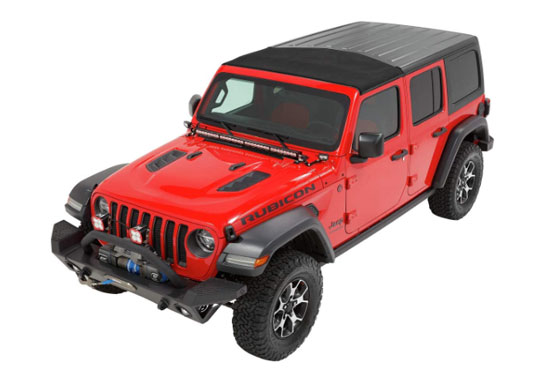The majority of Jeep owners are people who enjoy outdoor adventures like camping, kayaking, and off-road driving. To save space inside the vehicle for important things, like people, people want to place many items on top of the Jeep hardtop.
I often get asked how much weight a Jeep hardtop can support without cracking or leaking.
According to the manufacturer the Jeep hardtop is not designed to support any additional weight.
Jeeps and Roof Top Cargo
You have seen Jeeps on the roadways with roof racks, roof tents, kayak carriers, and bicycle carriers attached to their hardtops. The fact that the manufacturer says the hardtops are not designed to carry any additional weight does not seem to stop Jeep owners from loading them up.
The hardtop of a Jeep can actually safely support a weight of about 140 to 150 pounds. After that amount of weight, you are risking the hardtop’s integrity and stability.
What Are Jeep Hardtops Made of?

A lot of people assume that the Jeep hardtops are constructed from fiberglass. This is partially, but not completely, accurate.
A Jeep hardtop is made of sheet molding compound. There is compressed fiberglass in the base material of the compound. It also has things like polymer resin, release agents, and thickeners mixed in it.
This sheet molding compound is used on items that need to be very strong yet as light as possible.
SMC is a resilient and lightweight material but the material has a low level of stiffness and it is not extremely strong.
Roof Racks, Tents, and Carriers on a Jeep
Roof racks and items designed to help you carry more things with you when you set out on a journey are fabulous. They can also be hazards to your Jeep because they can compromise the hardtop and leave you having to replace the top or repair leaks and cracks in the top.
To safely travel with these items on top of your Jeep you need to always consider the weight and the way the items are loaded. The weight of the items must be properly distributed or you can endanger the safety of your roof and increase the possibility of accidents
Weight Distribution Considerations
The items you put on the rack should be distributed evenly.
- The heaviest items need to be in the center of the rack to help distribute the weight.
- The lightest items are usually placed on the bottom of the rack so the heavier items keep the lighter ones from flying off.
- Watch where you are placing the items and try not to load too much to the rear where things are easier to retrieve.
- You should always cover the items with a tarp to add security so things do not blow away
- Be sure to secure any long items that might hang over the vehicle with straps and ties
- Check the load before you leave. Try to shake the load to determine if anything has a tendency to move or shift.
- Center the heavy items between the doors of the vehicle. This is the area of the roof with the greatest load strength.
- Do not position items where they hang over the windshield of the vehicle as this can impede the drivers’ vision. Items hanging over the windshield can also create an updraft of wind that can lift the items off the roof of the vehicle.
Determining The Roof Rack Weight Limit on a Jeep

People have a wide variety of items they like to put on top of their vehicles when they are going on an adventure. The most common items carried on the top of vehicles are:
- Jerry cans
- Tents and various camping gear
- Luggage
- The spare tire for the vehicle
- Kayaks
- Bicycles
- Building materials
To understand the weight limit, you must consider the fact that a vehicle weight limit is established with the presumption that the vehicle is not in motion. So the weight limit is set for the vehicle to be standing still.
When you put the vehicle in motion the limit changes. The weight limit of a vehicle in motion is less than the limit for a vehicle that is stationary. You have to remember that while your vehicle is moving the items on top of it increase the wind resistance and will increase the amount of fuel you use to travel.
The weight limit is actually called a dynamic rating. This rating tells you the amount of weight the vehicle can carry and still remain safe. You can fi8nd your dynamic rating for your vehicle in the owner’s manual.
Once you have the dynamic rating you have to deduct the weight of the crossbars and roof rack assemblies because they are part of the weight the roof is supporting.
The roof rack may be designed to hold 600 pounds but if the dynamic rating of your vehicle says it can only support 200 pounds it means 200 pounds including the weight of the roof rack.
The amount of weight the manufacturer deems safe is the total amount of the weight of everything you place on the roof.
Tips From The Pros
- Never bury your spare tire on the roof rack. Make sure the spare tire is easy to access in case you need it.
- Containers hauling things like gasoline should be secured so they remain in an upright position.
- Never put gasoline or similar liquids in a container that does not have a secure lid on it.
- Have plenty of bungee straps to help you secure items to the crossbars of a roof rack and keep them from shifting during transport
- You can use packing tape or duct tape to secure lighter items so they are less likely to be lost in transport
- No living animal should ever be placed in a carrier on top of a vehicle
- Each time you stop be sure to check your load to make sure everything is copasetic
- When testing load safety it is recommended that you drive for about ten minutes then stop and check the load for security
- Drive slower than normal when you have a load on top of the vehicle or when you are hauling a load on a trailer
- Ratchet straps are safer and more secure than bungee straps. Bungee straps can be used to stabilize items together and then a ratchet strap can be used to secure the entire load.
- Be sure to check your tires and tire pressure before you head out with a load
More Jeep Articles>>
1. How to Clean Jeep Wrangler Soft Top & Windows
2. Jeep Wrangler Hard Top Leaking Fix
Frequently Asked Questions
Do Roof Racks Increase The Amount Of Weight A Hardtop Can Carry?
No, they do not. The roof rack makes it easier to distribute the weight and carry odd-shaped items but the dynamic rating for the vehicle does not increase due to a roof rack installation.
Do Roof Racks Cause Leaks?
These items can cause leaks if they are improperly installed or they are loaded heavier than they should be.
How Heavy Is The Typical Roof Rack?
A typical roof rack weight would depend on the size and design of the unit. You can expect a Kayak rack to weigh about 75 pounds, but a larger rack for luggage and accessories may weigh up to 165 pounds.
Final Thoughts
Carrying things on the roof of the vehicle does free up interior space. Always check the dynamic rating of your vehicle, and remember to evenly distribute the weight to avoid complications.

